Expanding your online presence to international markets is a thrilling endeavor that increases your growth potential. The world is becoming increasingly globalized, so it’s a smart choice to ensure your website content is internationalized to maximize reach.
This means you have to develop thorough plans for execution. And this goes beyond just translating content and throwing it up on your website. There are technical and SEO implications that need to be addressed as well.
With the right strategies, you can unlock the benefits of international search engine optimization, such as improved local search appearances, increased organic traffic, and getting qualified leads.
Here are five best practices that will help you understand and navigate the complexities of optimizing your website on a global level.
1. Consider Using Localized URLs or Subdomains
The foundation of solid international SEO for your website starts with its structure. Instead of employing a one-size-fits-all approach, think regionally. Consider implementing localized URL structures with subdomains that correspond to specific geographic areas.
For instance, instead of solely using www.yourwebsite.com, you might opt for www.yourwebsite.co.uk to specifically cater to the UK market.
In the example below, Samsung puts this localization to work using www.samsung.com/uk for its UK website and www.samsung.com/us for its U.S. customers.
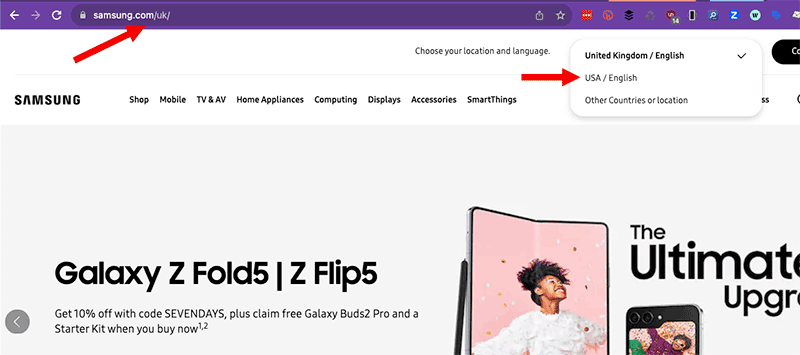
There are numerous places to buy a .co.uk domain as well as a domain for other locations like .au (Australia), .us (United States), .cn (China), and so on. These domain platforms may also include email hosting services so you can secure a matching business email address for sharing content.
By using localized URLs or subdomains, you can ensure that your website content is tailored to the preferences of your international target audience. This allows you to optimize your website and improve the user experience.
Additionally, localized URLs or subdomains can help with search rankings, as search engines will be more likely to recognize and prioritize localized content.
2. Use Localized Keywords
Localized keywords are another important factor for a successful international SEO strategy. When venturing into international markets, your keyword strategy should be both precise and culturally aware.
Begin by conducting in-depth research into the language and search behaviors of your target audience in each region. Use tools like Google Keyword Planner to uncover region-specific keywords and trends. For instance, if you’re a US-based shoe manufacturer branching out to a market in Canada, here’s how you can use Google Keyword Planner to find local keywords.
First, go to Google Ads, click on tools, then keyword planner. Enter your keywords and select your preferred location as seen below:
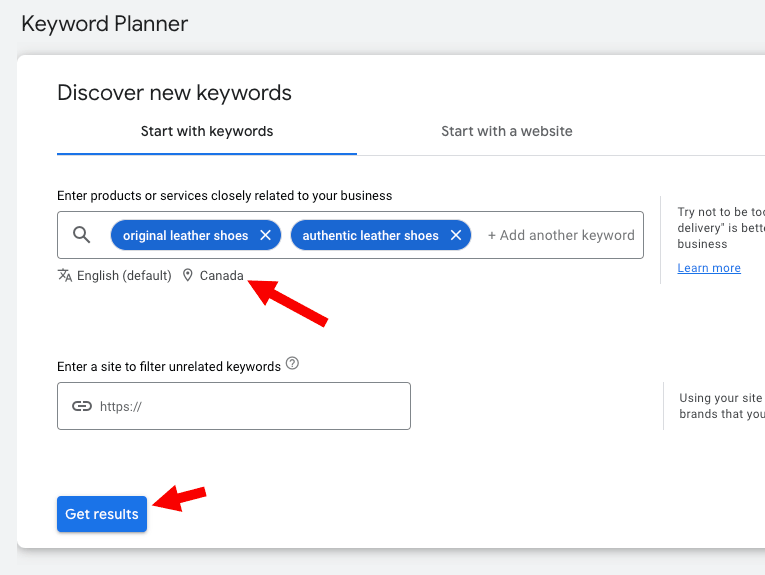
Next, you’ll see a list of keyword suggestions along with the search volume and the level of competition for each one.
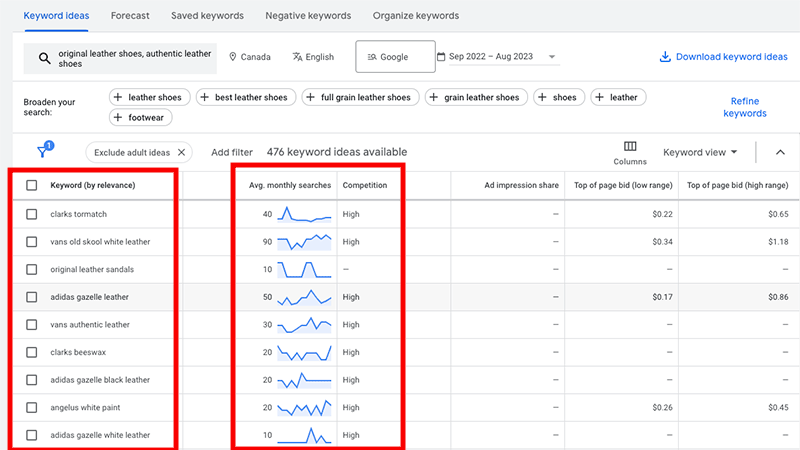
You want to go for international keywords with low competition and a high search volume, as this means that not a lot of brands are competing for the keywords. So, that’ll give you an opportunity to grow your manufacturing business online using specific search terms. Of course, this process also works for eCommerce brands, SaaS brands, or any type of business website you want to optimize internationally.
Once you’ve identified these localized keywords, you can strategically incorporate them into your website’s content. This means creating or modifying your web pages, blog posts, product descriptions, and other content to naturally include these keywords. It’s important to do this in a way that enhances the user experience and doesn’t come across as forced or unnatural.
Keep in mind the user’s intent behind their search queries. Understand what potential customers are looking for and tailor your content to fulfill those needs. This approach not only improves SEO but also enhances the user experience, making your website more valuable to visitors.
When implemented well, localized keywords can help to attract more qualified leads, as they will be more likely to find your website content when searching for specific keywords. Other helpful tools you can use to find localized search terms include Semrush, Ubersuggest, and Ahrefs.
3. Set Up Hreflang Tags
Href Language tags are HTML annotations that you add to your web pages. They are used to specify the language and regional targeting of each page. This guarantees that search engines display the most relevant pages to users based on their language and location. So, it can boost your local content discovery efforts.
Incorrectly implemented hreflang tags can lead to confusion and negatively impact your website’s visibility. Search engines might struggle to determine which version of your content to display for a particular audience, resulting in lower rankings or irrelevant search results.
Here’s how to set up hreflang tags effectively:
First, determine which languages and target countries you’ll be working with. This step is crucial as it forms the basis for your Hreflang tags.
Within the HTML code of each page, include hreflang tags that specify the language and regional targeting. The format typically looks like this:
<link rel="alternate" hreflang="x" href="https://www.yourwebsite.com/page">
“x” represents the language and region code. So if you want to optimize for French speakers, for instance, you’d have:
<link rel="alternate" hreflang="fr" href="https://www.yourwebsite.com/page">
Here’s an image to make this clearer:
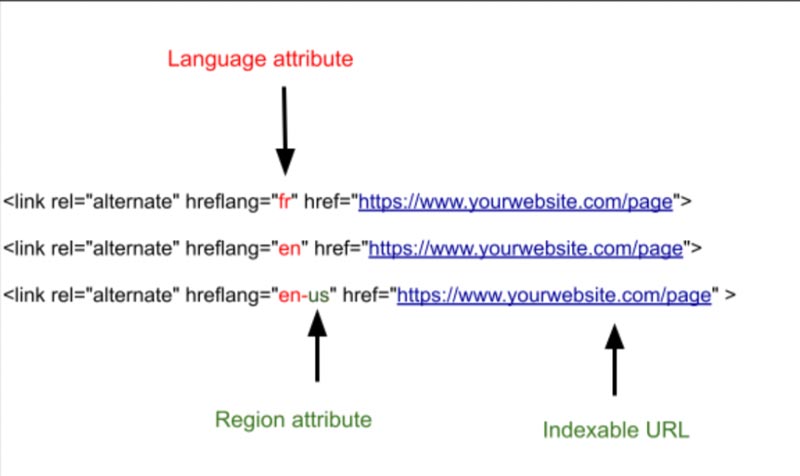
After adding hreflang tags, thoroughly cross-verify them to ensure accuracy. Tools like Google’s Search Console offer validation features to confirm that your tags are correctly implemented. Ensure that the tags are correctly placed in the HTML of each page. Verify that the language and region codes used in the tags are accurate and match your intended targeting.
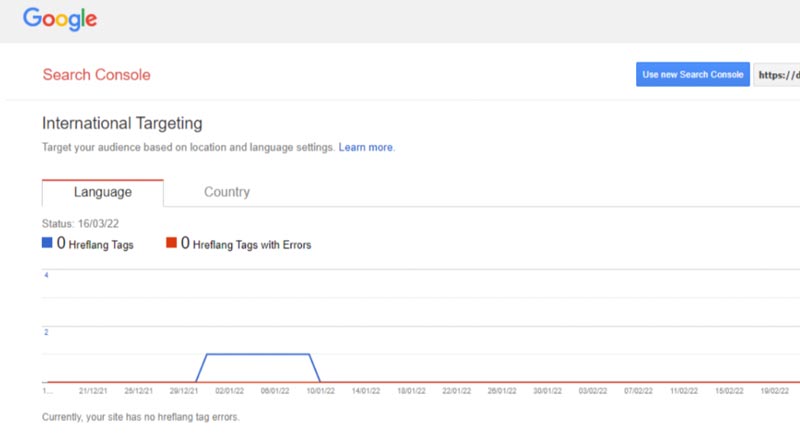
Regularly test and monitor your international SEO performance. Ensure that search engines are correctly associating your pages with the intended languages and regions.
By setting up hreflang tags, you can ensure that search engines can recognize and prioritize localized content — potentially boosting your search rankings.
4. Customize Content to Suit the Local Culture
Going beyond language translation, a successful international website customizes its content to align with the local culture. When localizing your content, remember that idioms, expressions, and colloquialisms vary from country to country. Sometimes, what is considered a common phrase in one language may sound odd, confusing, or even offensive when directly translated into another.
A popular example is what happened when Coca-Cola launched in China. The brand name “Coca-Cola” was initially transliterated into Chinese. The term was intended to mean “Tasty Fun” or “Delicious Happiness.” However, the pronunciation in Chinese sounded like “Bite the Wax Tadpole.” This translation was far from conveying the refreshing and appealing nature of Coca-Cola.
Also, consider adapting visuals like images and videos, design elements, and even product offerings to create a deep connection with each unique culture. Cultural sensitivity demonstrates your commitment to building meaningful relationships with your international audience. Here’s an example of Slack using engaging visuals on the French version of its site:

It’s advisable to work with a native speaker who is bilingual — fluent in both your primary language and your target language. This approach helps minimize the risk of translation errors and ensures that the content resonates effectively with the local target market.
In some cases, it may even be necessary to employ a transposition strategy, where terms are adjusted to fit the cultural context, rather than pursuing a literal word-for-word translation. This way, you’ll achieve a more seamless adaptation to the cultural application of your target region.
By customizing your site’s relevant content to suit the local culture, you can ensure that locals can understand and relate to your brand, boosting your overall appeal.
5. Optimize Website Performance
To ensure a seamless user experience across various geographical locations, prioritize the optimization of your website’s speed and responsiveness.
First, ensure that you select a reputable hosting provider known for fast servers, uptime, and excellent customer support. The hosting plan you choose should align with your website’s needs, whether it’s shared hosting, VPS (Virtual Private Server), or dedicated hosting. Some of the best web hosting providers for beginners are WPX, Siteground, and Flywheel. Be sure to look at reviews before making a choice.
Also, partner with content delivery networks (CDN) like Cloudflare, Akamai, or Amazon CloudFront. These CDNs will cache and distribute your content to servers worldwide, reducing load times, and improving the delivery of your website’s assets.
Additionally, you should ensure that your website is optimized for different devices and browsers, as this can help to improve user experience. Employ responsive web design techniques, using HTML and CSS frameworks like Bootstrap or CSS Grid, to create a flexible layout that adjusts seamlessly to different screen sizes.

By providing international customers with a speedy and responsive website, you not only enhance their satisfaction but also strengthen your position in global search rankings — ultimately contributing to the success of your international SEO endeavors.”
In Closing
Internationalizing website content is essential for businesses that want to maximize their reach. By employing the right strategies, you can ensure a wider audience sees your website and maximizes your potential.
In this article, we discussed the five best practices for internationalizing website content. They include: considering localized URLs or subdomains, using localized keywords, setting up Hreflang tags, customizing content to suit the local culture, and optimizing website performance.
Now that you know these tips, put them to work as you continue to optimize your international SEO efforts.
For more great tips, tricks, and how-to’s, subscribe to the DivvyHQ blog today!